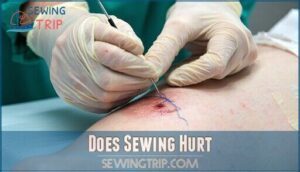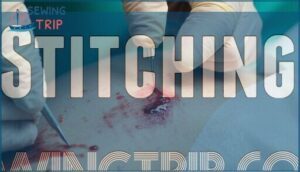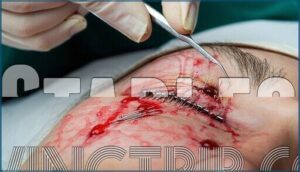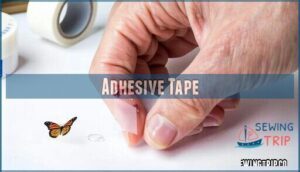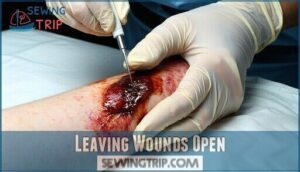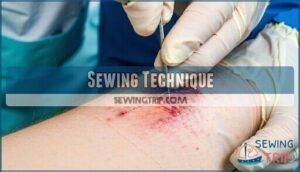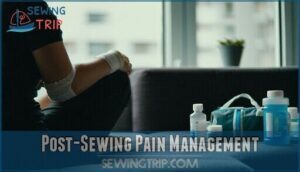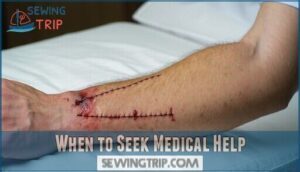This site is supported by our readers. We may earn a commission, at no cost to you, if you purchase through links.
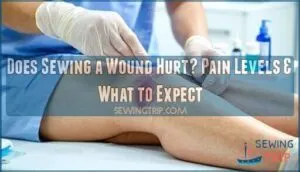
You’ll feel a brief sting from the numbing injection, then just pressure and tugging sensations during stitching.
Without anesthesia, it’d be quite painful, but modern medical practice guarantees you’re comfortable throughout the procedure.
Your individual pain tolerance plays a role, though most patients find the experience more tolerable than expected.
The anticipation often feels worse than reality.
Post-procedure soreness is normal and manageable with over-the-counter pain relievers, while proper wound care minimizes discomfort during healing.
Understanding the specific techniques and pain management strategies can help you prepare mentally for what lies ahead.
Table Of Contents
Key Takeaways
- You’ll feel minimal pain during stitching thanks to local anesthesia that numbs the area – you’ll only experience a brief sting from the injection followed by pressure and tugging sensations.
- The anticipation is typically worse than the actual procedure, as modern medical practices ensure you’re comfortable throughout the entire wound closure process.
- Post-procedure soreness is normal and manageable with over-the-counter pain relievers, usually peaking within 24-48 hours before gradually improving.
- Your pain tolerance and the wound’s location affect your experience, but most patients find the process more tolerable than they initially expected.
Wound Closure Process
When you need stitches, healthcare providers follow a systematic wound closure process that includes thorough cleaning, proper anesthesia application, and precise suturing techniques.
This structured approach guarantees the best healing while minimizing discomfort and reducing your risk of complications like infection or excessive scarring.
Stitching Techniques
Throughout wound repair, healthcare providers select from several suture methods based on your specific injury.
Each stitch pattern offers unique benefits for tissue repair:
- Simple interrupted stitches – Most common technique, allowing individual removal if needed
- Continuous running stitches – Faster closure for longer wounds using single thread
- Mattress stitches – Provide extra strength and better edge alignment for deeper cuts
- Subcuticular stitches – Hidden placement reduces visible scarring on sensitive areas
These needle techniques guarantee proper wound closure while minimizing discomfort during healing.
One common method involves simple interrupted sutures placed 2-5 mm apart.
Anesthesia Options
Your healthcare provider will choose the right pain relief option for your wound’s size and location. Local anesthetics like lidocaine are most common for medical stitches, injected directly into the tissue.
For sensitive areas, topical creams provide gentle numbing before injection methods begin. Complex wounds may require regional blocks targeting nerve pathways.
This careful pain management approach guarantees your medical procedure stays comfortable throughout the wound care process. The use of effective wound numbing agents is vital in minimizing patient discomfort during the procedure, ensuring a smooth experience with proper wound care.
Preparing The Wound
After anesthesia takes effect, your healthcare provider begins wound assessment and skin preparation. This critical step guarantees the best possible tissue repair and reduces infection risk.
Proper wound preparation is the foundation that determines your healing success and prevents dangerous complications.
The wound cleaning and debridement process involves:
- Removing debris – Foreign particles that could compromise healing
- Irrigating thoroughly – Saline solution flushes out bacteria and contaminants
- Trimming damaged tissue – Cleanly cut edges promote better wound closure
- Sterilizing the area – Antiseptic application creates a clean surgical field
Proper preparation directly impacts how much stitches hurt during recovery and prevents complications that could delay healing.
Does Sewing Hurt
With proper anesthesia, you shouldn’t feel sharp pain during wound sewing, though you might sense some pressure or tugging.
Pain levels vary based on wound location, depth, and your personal tolerance.
Most patients describe the numbing injection as the most uncomfortable part—like a brief bee sting that quickly fades.
The actual stitching process feels more like gentle pulling than cutting.
Your patient experience depends on several factors: wound size, sewing techniques used, and how well the anesthesia works.
Some areas, like fingers or scalp, might be more sensitive despite numbing.
After the procedure, expect mild soreness as healing begins.
This discomfort typically peaks within 24-48 hours, then gradually improves.
The healing process involves natural tissue repair, which can cause some tenderness.
Over-the-counter pain relievers usually manage post-procedure discomfort effectively, helping you stay comfortable while your body mends itself.
Understanding arthritis prevention methods can also help reduce long-term risks associated with repetitive activities like sewing.
Wound Closure Methods
When you need wound closure, doctors have several methods beyond traditional stitching.
Your options include staples for speed, adhesive tape for minor cuts, or sometimes leaving wounds open to heal naturally.
Stitching
When stitches pain concerns you, understanding suture materials helps.
Your doctor selects specific threads based on wound tension and location.
Different stitch patterns minimize tissue damage while supporting proper wound healing.
The technique affects scar formation – tighter stitches aren’t always better.
Modern suturing methods prioritize comfort during sewing wounds and easier stitches removal later.
The choice of suture threads depends on the type of suture thread options available for various wound closure methods.
Staples
Surgical staples offer a faster alternative to traditional stitches for wound closure.
These metal clips create secure wound edges in seconds, though you’ll feel brief sharp discomfort during application.
Most patients report minimal staple removal pain, with studies showing lower immediate pain levels compared to sutures.
Staple care involves keeping the area clean and dry.
Professional staple removal typically occurs within 7-21 days, depending on wound healing progress and location.
Patients can learn more about proper wound care techniques to guarantee a smooth recovery and understand the importance of wound care.
Adhesive Tape
For minor cuts that don’t require stitches, adhesive tape offers a gentler alternative.
Medical professionals use specialized skin adhesives and wound dressing materials that provide adequate wound support without needles.
Three main tape types include:
- Butterfly strips – Pull wound edges together effectively
- Medical tape – Secures gauze and bandages properly
- Liquid adhesives – Create waterproof seals for small cuts
Tape removal requires careful technique to prevent wound pain during sewing injury recovery.
This wound treatment method works best for shallow wounds needing minimal wound repair support.
Leaving Wounds Open
Sometimes doctors choose not to close certain wounds immediately.
When you leave wounds open, they heal naturally through a process called secondary intention.
This approach works best for infected wounds, deep punctures, or cuts with significant tissue damage.
Open wound care requires regular cleaning and dressing changes to prevent wound infection.
You’ll need to monitor for signs of poor wound healing, excessive wound pain, or abnormal scar tissue formation during the wound healing process.
Sewing for Healing
When you’re facing a wound that needs stitches, the sewing process does more than just close the gap.
Proper suturing minimizes scarring, reduces infection risk, and promotes ideal tissue repair by bringing wound edges together in perfect alignment, which is crucial for ideal tissue repair and healing.
Minimizing Scarring
Proper wound sewing techniques play a pivotal role in scar prevention.
When healthcare providers use tension-reducing sutures and layered healing techniques, your skin regeneration improves dramatically.
Studies show these methods can cut scar width from 1.7cm to just 0.7cm.
The suturing approach directly impacts your tissue repair process, making thoughtful wound care decisions worthwhile for long-term results.
Reducing Infection Risk
Beyond appearance, proper wound cleaning and infection control matter most for healing.
Healthcare providers use sterilization methods and hygiene practices to prevent wound infection during medical treatment. This approach supports the wound healing process through systematic wound management.
- Antibiotic use prevents bacterial growth when prescribed appropriately
- Sterile instruments eliminate contamination during the procedure
- Proper wound cleaning removes debris and reduces bacterial load
- Post-procedure care maintains cleanliness until healing begins
Promoting Tissue Repair
Proper wound sewing supports cellular regeneration by aligning tissue edges perfectly.
The wound healing process accelerates when medical sewing creates ideal conditions for tissue growth.
Your body’s natural injury recovery mechanisms work better with precise wound care techniques.
Professional scar management begins with correct tissue repair methods, ensuring the sewing skin procedure promotes faster healing and healthier outcomes.
The key to successful wound healing lies in precise wound care techniques and correct tissue repair methods, which are essential for optimal recovery.
Sewing Procedure Details
Understanding the step-by-step process helps you know what to expect during wound repair.
You’ll experience three main phases: numbing the area with local anesthetic, thorough cleaning and preparation of the wound site, and the actual suturing technique performed by your healthcare provider.
Numbing The Area
Your doctor will numb the area before sewing skin to guarantee pain relief during wound care.
Local numbing with lidocaine injection is standard – the needle goes through the wound margin, then anesthetic spreads as it’s withdrawn.
Topical anesthetics work for surface cuts, while nerve blocks handle deeper injuries.
You’ll feel a brief sting during skin preparation, then complete numbness within minutes.
Cleaning and Preparation
Once your wound is properly numbed, thorough wound cleaning becomes the next priority.
Healthcare providers follow strict sterilization methods to prevent complications and promote healing conditions.
- Wound Cleaning: Irrigate with sterile saline solution to remove debris and bacteria
- Skin Prep: Cleanse surrounding area with antiseptic solution in circular motions
- Antiseptic Use: Apply iodine or chlorhexidine to eliminate surface pathogens
- Tissue Handling: Use sterile instruments to gently manipulate wound edges
- Sterilization Methods: Maintain sterile field throughout entire wound care process
Sewing Technique
Once your wound is properly cleaned, the healthcare provider begins the actual suturing process.
They’ll select the appropriate needle size and thread material based on your wound’s depth and location.
Using precise needle control, they’ll create consistent stitch patterns while maintaining gentle tissue handling.
Each suture method varies, but the goal remains the same: bringing wound edges together for ideal healing.
Sewing Time and Factors
The time it takes to sew your wound depends on several key factors that your healthcare provider will assess.
Your wound’s size, depth, location, and your overall health all play important roles in determining how long you’ll spend getting stitched up, considering your overall health.
Time Varies by Wound Size
Small wounds take just minutes to stitch, while larger injuries require considerably more time.
A paper cut-sized laceration might need only two or three sutures, completed in under five minutes.
However, extensive wounds spanning several inches can take thirty minutes or longer.
The wound size directly impacts healing time and scar formation, affecting your overall recovery speed and wound care requirements.
Depth and Complexity Factors
Through deeper layers, wound complexity affects both pain threshold and healing time substantially.
Muscle involvement creates greater tissue damage, requiring layered closure that extends procedure duration.
Complex wounds with irregular edges increase scar formation risk and demand specialized wound care techniques.
Your pain threshold determines comfort levels during multi-layer repairs, while deeper medical wound injuries typically need extended injury care protocols for the best wound healing process steps.
Understanding fabric characteristics like fabric weight matters is vital for creating comfortable and durable medical textiles, which is crucial for the best wound healing process.
Patient Health Considerations
Your overall health status substantially impacts both pain management and wound healing timeline during medical intervention.
Chronic conditions like diabetes or immune disorders can slow tissue repair, requiring extended wound care and specialized attention to your comfort levels.
Healthcare providers assess your pain threshold and adjust treatment protocols accordingly, ensuring patient safety while minimizing health risks throughout the healing process.
Post-Sewing Pain Management
After your wound gets sewn up, you’ll likely experience some discomfort as the anesthesia wears off and your body begins healing.
Managing this post-procedure pain effectively helps guarantee proper recovery and keeps you comfortable during the critical first few days, which is crucial for proper recovery.
Common Discomforts
After wound closure, expect several types of discomfort during healing.
Pain levels typically range from mild to moderate, with tightness and soreness being most common.
You’ll likely experience wound irritation, including an itching sensation as tissues repair.
Swelling issues around the stitched area are normal, along with redness and warmth.
These discomforts indicate proper wound healing processes.
Alleviating Pain and Swelling
Several techniques can effectively manage post-surgical discomfort and promote ideal healing.
Here’s what works best for Pain Relief and Swelling Reduction:
- Apply ice packs for 15-20 minutes every 2-3 hours during the first 48 hours
- Keep the wound elevated above heart level when possible to reduce swelling
- Take prescribed anti-inflammatory medications as directed by your healthcare provider
- Use compression garments or bandages to minimize tissue swelling
- Avoid heat application, which can increase inflammation and delay the Healing Process
Additionally, engaging in activities that promote mental wellbeing, such as those involving stress relief techniques, can also aid in the recovery process.
Medication and Self-Care
Over-the-counter pain relief medications like ibuprofen help reduce inflammation and discomfort following wound care procedures.
You’ll want to follow dosage instructions carefully and combine medication use with proper first aid techniques. Keep the area clean, apply ice wrapped in cloth, and monitor for signs requiring additional medical advice during your self healing process.
For effective pain management, it’s essential to understand the role of pain relief medication in wound care.
| Medication Type | Purpose | Usage Guidelines |
|---|---|---|
| Ibuprofen | Reduces inflammation and pain | Take every 6-8 hours with food |
| Acetaminophen | Pain relief without anti-inflammatory effects | Follow package directions, avoid alcohol |
| Topical antibiotics | Prevent infection at wound site | Apply thin layer twice daily |
| Ice packs | Minimize swelling and numbness | Use 15-20 minutes at a time |
| Clean dressings | Protect healing tissue | Change daily or when wet/dirty |
When to Seek Medical Help
While most wound closures heal without complications, you should contact your healthcare provider if you notice signs of infection like increased redness, warmth, or pus around the stitches.
Seek immediate medical attention if you experience severe pain that doesn’t improve with medication, excessive bleeding that soaks through bandages, or unusual swelling that gets worse after the first few days, which may indicate a need for urgent care due to potential complications.
Signs of Infection
Watch for spreading Redness Signs around your stitched wound – this infection risk often appears as bright red areas extending outward.
Fever Symptoms, increasing Swelling Causes, or thick Pus Formation signal your body’s fighting bacteria.
These warning signs need immediate medical advice since untreated Infection Risks can complicate wound healing after any surgical procedure requiring proper wound care.
Unusual Pain or Swelling
Sharp increases in pain levels or swelling beyond normal healing patterns signal potential complications.
Watch for throbbing pain that worsens instead of improving, or swelling that spreads beyond the wound site.
These symptoms often indicate wound infection, tissue damage, or nerve irritation requiring immediate medical attention.
Don’t ignore your body’s warning signals—prompt wound care prevents serious medical emergency situations, and it’s crucial to recognize these signs to ensure proper treatment and avoid further complications.
Excessive Bleeding or Discharge
Normal bleeding after wound sewing typically stops within hours, but excessive bleeding or unusual discharge signals trouble.
Hemostasis should occur naturally as wound healing stages progress. Watch for signs that require immediate medical attention:
- Continuous bleeding that soaks through bandages
- Bright red blood flowing freely from the wound
- Pus-filled or foul-smelling discharge management issues
- Fluid loss exceeding normal wound drainage patterns
- Bleeding control measures failing after direct pressure
Proper wound care often involves having the right first aid tools available, including recognizing medical emergency situations early, to ensure proper wound care and applying bleeding control measures. Contact medical professionals immediately if these symptoms appear, as immediate medical attention is crucial in such cases.
Frequently Asked Questions (FAQs)
How painful is stitching a wound?
Suturing discomfort varies from mild to moderate depending on your wound’s location, depth, and pain tolerance.
You’ll typically feel pressure and tugging sensations rather than sharp pain, especially with proper local anesthesia administered beforehand, which can significantly affect the perceived discomfort.
Does it hurt to sew a wound?
Yes, you’ll feel pain when getting stitches, but doctors use local anesthetic to numb the area first. The injection stings briefly, then you’ll only feel pressure and tugging during suturing.
What happens when you stitch a wound?
When you stitch a wound, you’re basically creating a bridge that holds torn tissue together while your body heals naturally.
The sutures guide new cells to grow across the gap, forming stronger scar tissue.
Is skin stitching painful?
No pain, no gain" doesn’t apply here.
You’ll feel minimal discomfort during skin stitching since local anesthetic numbs the area first.
The injection stings briefly, then you’re comfortable throughout the procedure.
Can you sew a wound at home?
You shouldn’t attempt home suturing without proper medical training and sterile equipment.
Minor cuts can be managed with butterfly bandages or adhesive strips, but deeper wounds requiring stitches need professional medical attention for safety.
How long do stitches stay in wounds?
Surgical suture schedule stays steadily specific: you’ll typically wear stitches for five to fourteen days.
Location matters—facial wounds heal faster, requiring removal around day five, while joints and high-tension areas need the full two weeks for proper healing.
What happens if stitches get wet accidentally?
Getting your stitches wet accidentally won’t cause immediate disaster, but you’ll need to act quickly.
Gently pat the area dry, avoid rubbing, and monitor for signs of infection like increased redness or swelling.
Are there alternatives to traditional sutures?
Consider a mountain climber who slips and needs quick wound closure—you’ve got several modern alternatives beyond traditional stitches.
Skin adhesives, surgical tape strips, and staples offer faster application with less discomfort than needle-and-thread suturing for appropriate wounds, utilizing modern alternatives.
Do children need special wound closure considerations?
Yes, children require specialized wound closure approaches due to their thinner skin, higher pain sensitivity, and tendency to move during procedures.
You’ll need child-friendly techniques, appropriate anesthesia, and often faster closure methods to minimize trauma and guarantee proper healing.
Conclusion
Picture yourself sitting in the emergency room, heart racing as you wonder about the upcoming procedure.
Fortunately, modern wound care guarantees that asking "does sewing a wound hurt" yields reassuring answers.
You’ll experience minimal discomfort during stitching thanks to effective local anesthesia.
While you might feel pressure and tugging sensations, actual pain remains well-controlled throughout the process.
Post-procedure soreness responds well to standard pain management techniques, making your recovery smoother than anticipated.

